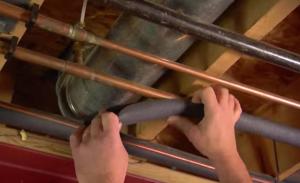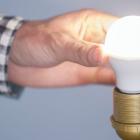Protect the environment: Keep those pipes piping hot
Submitted by Miranda Maisto on | Updated Thu, 15/06/2017 - 22:34

By insulating some of the pipes in your hot water heating system, you can save money and protect the environment through the same do-it-yourself household improvement.
If you are a conscious home-owner or just plain environmentally conscious the benefits of insulating your hot water heater pipes are many.
Best of all this do-it-yourself home projects doesn't take much time or money, and gladly doesn't require a deep rooted knowledge in plumbing.
Some questions you may be asking at this point are:
-
What’s the money situation?
-
The startup cost is roughly $20-$30. This is just the cost of supplies and you can even shop around for the best deals at your local hardware stores.
-
On average many households have their investment fully returned in 2-3 years depending on usage. For a home owner this is no time at all!
-
On average insulating your pipes can save you $10 annually on your heating bill.
-
-
Ok this helps to protect the environment but how much CO2 can I save?
-
By insulating your pipes it is estimated you are able to save and average of 46kg of CO2 per year.
-
-
How much energy can I save?
-
Overall, insulating pipes can save approximately 43 kWh per person per year in water heating energy
-
-
And finally – Is it really as easy as you say it is?
-
This tip take around 3 hours for a small house. The hardest part about insulating your hot water heater pipes is going out to get the supplies from your local hardware store and even then, this isn’t that bad as retiling your guest bathroom! Further in this post you find will the full step-by-step instructions to see just how simple this project is.
-
Insulating your hot water pipes is often an overlooked idea because the hot water heating system is usually out of sight. Even I don’t think about my hot water heating system unless my bill is unusually high, but just because the water heating system is something that’s not in the front of my mind all day, it does not make it any less important than other places in my home where I can try to be cost conscious all while helping to protect the environment.
Before diving in to the big questions and the how-to, it’s important to understand what your water heater is and does. Generally speaking, the hot water heater system has a reserve of hot water at all times so when you go to shower or wash the dishes you don’t have to wait for the water to boil. Constantly keeping water hot is very energy consuming. The other key point to understand is that many hot water heating systems are the branch and tree style (a big tank as the trunk and pipes protruding out like branches). Having uninsulated pipes extending from the tank will cause the water to loose heat and waste the energy it takes the water heating system to distribute the water.
On first glance, the answers some of the questions listed above are just numbers so allow me to expand. An uninsulated pipe is expected to consume 1,190 kWh per year per person. Also, 13% to 29% of water heating energy is attributed to solely distribution, the transport of water from the water heater to the faucet. Remember that your hot water heater’s main purpose is to always have hot water ready and waiting for you to shower, wash your hands, ect.
So, if you were to insulate just the start of your exposed pipes closest to the water heater tank, your pipes you are able to reduce the amount of energy consumed and increase the at-the-faucet water temperature by 2 to 3 degrees.
For a more understandable comparison think of a traditional family of four. This could be a very noticeable adjustment on your bill and not so noticeable adjustment to your family’s lifestyle. The same family of four taking 5-minute showers each uses nearly 700 gallons of water in total with only an 11%-22% water efficiency. This is already a substantial amount for such little time. Now factor in the extra 5 minutes a day they each take to wait for the water to get warm.
With the better understanding of the pros and cons the next question you are probably asking is “How do I do it and will it be worth the investment?”
Here is what you will need:
-
That tape measure you last used to see if your new mattress will fit through your bedroom door.
-
Pipe sleeves or fiberglass insulation. This is something that can be found at any hardware store and cost about $5-$6 per 3 feet. (Remember we are only looking at the pipes that are exposed near the base of the water heater. Not going throughout the house).
-
Something to secure the sleeve around your pipes. People most commonly use duct tape, zip ties, or aluminum foil tape.
-
Anything that will safely and effectively cut the insulation to size.
Safety Suggestions:
If you are using fiberglass pipe insulation make sure to wear glove and jeans without holes. protect the environment
Also, be sure you pre-evaluate if you will need additional lighting such as a headlamp or a friend to hold your phone light. This is just in case your water heater is in a crawl space or another dark place.
Questions to answer before you start:
-
What type of insulation will you want to use?
-
Electric water heaters most commonly use polyethylene or neoprene foam. Again, this is something that will be at your local hardware store.
-
For gas water heaters, fiber glass is the best option. What is great about fiber glass piping is that most hardware stores will carry it with a cut down the middle so all you have to cut the pipe insulation to length rather than worry if the line down the middle is straight. It’s like the stuff was made for this or something!
-
-
How much insulation you will need?
-
Make sure to not only measure the length of the pipes but also take note of the pipes outside diameter and the sleeves inside diameter. Being off on these measurements may void any positive impact you are looking for because of the heat escaping. Remember, the primary purpose is to insulate, not let the heat escape!
-
For gas heaters specifically, the insulation should start about 6 inches away from the base. This is for safety but I look at it as less to invest for your return.
-
What’s left for this tip to help protect the environment?
One you have your measurements and made your quick trip to the hardware store the project is more than half done.
The next step is to cut the pipe sleeve to the proper length. Remember the general rule of thumb is to measure twice and cut once.
Finally, once all your pieces are cut you can place them around the various pipes and secure them with your fastener. The sleeves should be snug and the pipes fully covered all around. As mentioned before, if there is any wiggle room or exposed pipe where the insulation should be, you will void or reduce the benefits.
Was it worth it?
Overall this project helps to protect the environment and should take no more than one afternoon including your trip to the hardware store. Depending on how much exposed piping, this project should be an easy investment of $20-$30. And now that you have read this article you technically have all the knowledge you need to be successful in your efforts. There is no need to hire a plumber or handy man with a $200 evaluation fee when you can you take pride that you can DIY this tip to help protect the environment! ….combined with the other benefits that is.
Here is a video that will best visualize how to insulate your pipes:
http://energy.gov/energysaver/projects/savings-project-insulate-hot-wate...
Sources:
http://www.scgh.com/go-green/water-fixtures-and-plumbing/conventional-wa...
https://www.houselogic.com/organize-maintain/home-maintenance-tips/water...
http://www.energysavingtrust.org.uk/home-insulation/insulating-tanks
https://www.saveonenergy.com/energy-saving-tips/how-does-saving-energy-help-the-environment/
http://energy.gov/energysaver/projects/savings-project-insulate-hot-water-pipes-energy-savings
Image credit:
http://cdn.thehomestory.com/wp-content/uploads/2016/05/Slide4insulating-...
You will save the Earth by sharing and/or tweeting (corny right?)





